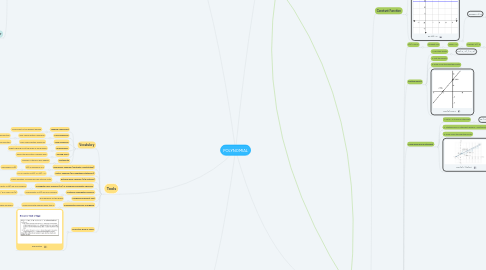
1. Definition
1.1. Polynomial Function Form
1.1.1. an, an-1,..., a2, a1 are the coefficient
1.1.2. a0 is called a constant
1.1.3. ^n is degree of the polynomial
1.1.3.1. Highest exponent on the variable x
1.1.4. an is the leading coefficient
1.1.4.1. Coefficient on the highest degree term
1.2. Types of polynomials
1.2.1. Monomials
1.2.1.1. Algebraic expression with 1 term
1.2.1.1.1. Ex: 12, 3x^2
1.2.2. Binomials
1.2.2.1. Algebraic expression with 2 unlike terms
1.2.2.1.1. Ex: 3x^4+2x
1.2.3. Trinomials
1.2.3.1. Algebraic expression with 3 unlike terms
1.2.3.1.1. Ex: 7x^6+2x^4+3
1.2.4. More than 3 terms
1.3. Degree of Polynomials
1.3.1. Degree 0
1.3.1.1. Constant Function
1.3.1.1.1. f(x) = b
1.3.2. Degree 1
1.3.2.1. Linear Function
1.3.2.1.1. f(x) = mx+b
1.3.3. Degree 2
1.3.3.1. Quadratic Function
1.3.3.1.1. f(x) = ax^2+bx+c
1.3.4. Degree 3
1.3.4.1. Cubic Function
1.3.4.1.1. f(x) = ax^3+bx^2+cx+d
1.3.5. Degree 4
1.3.5.1. Quartic Function
1.3.5.1.1. f(x) = ax^4+bx^3+cx^2+dx+e
1.3.6. Degree 5
1.3.6.1. Quintic Function
1.3.6.1.1. f(x) = ax^5+bx^4+cx^3+dx^2+ex+f
1.3.7. More than degree 5
1.4. Regulations
1.4.1. Powers are non-negative integers
1.4.2. Coefficients are real numbers
2. Tools
2.1. Vocabulary
2.1.1. Leading Coefficient
2.1.1.1. Coefficient of the highest degree
2.1.2. Local Maximum
2.1.2.1. Also called relative maximum
2.1.2.1.1. Greatest value in the function
2.1.3. Local Minimum
2.1.3.1. Also called relative minimum
2.1.3.1.1. Least value in the function
2.1.4. End Behavior
2.1.4.1. What is going on at the ends of each graph
2.1.5. Turning Point
2.1.5.1. Which the derivative changes sign
2.1.6. Multiplicity
2.1.6.1. Number of times a zero appear
2.2. Remainder Theorem (Synthetic Substitution)
2.2.1. f(x) is divided by x-k
2.2.1.1. Remainder is f(k)
2.3. Factor Theorem (Bi-Conditional statement)
2.3.1. x-c is a factor of f(x) ⟺ f(c) = 0
2.4. Rational Zero Theorem (P/Q method)
2.4.1. Check whether a polynomial has rational roots
2.5. Conjugate Pairs Theorem (PC) or Complex Conjugates Theorem
2.5.1. Coefficients of f(x) are real numbers
2.5.1.1. x = a+bi is a zero of f(x)
2.5.1.1.1. x = a-bi is also a zero of f(x)
2.6. Irrational Conjugates Theorem
2.6.1. Coefficients of f(x) are real numbers
2.6.1.1. x = a+√b is a zero of f(x)
2.6.1.1.1. x = a-√b is also a zero of f(x)
2.7. Leading Coefficient Test
2.7.1. End behavior of the graph
2.8. Fundamental Theorem of Algebra
2.8.1. Polynomial with degree larger than 0
2.8.1.1. At least one root in the set of complex numbers
2.9. Descartes' Rule of Signs
2.9.1. Explanation
3. Factor
3.1. Quadratic Function
3.1.1. Factoring
3.1.1.1. Factoring out common factors
3.1.1.1.1. Each term shares a common factor
3.1.1.2. The sum-product pattern
3.1.1.2.1. The polynomial is x^2+bx+c
3.1.1.3. The grouping method
3.1.1.3.1. The polynomial is ax^2+bx+c
3.1.1.4. Perfect square trinomials
3.1.1.4.1. First and last terms are perfect squares
3.1.1.5. Difference of squares
3.1.1.5.1. Expression represents a difference of squares
3.1.2. Completing the square
3.1.2.1. Use standard Form: ax^2+bx+c=0
3.1.2.1.1. Ex: x^2+4x+1 = 0
3.1.2.2. 1. Divide all terms by a
3.1.2.2.1. Ex: x^2+4x+1 = 0
3.1.2.3. 2. Move c/a to the right side
3.1.2.3.1. Ex: x^2+4x = -1
3.1.2.4. 3. Complete the square on the left side
3.1.2.4.1. Adding the same value to the right side
3.1.2.5. 4. Take the square root on both sides
3.1.2.5.1. Ex: x+2 = ±√3
3.1.2.6. 5. Subtract the number that remains on the left side
3.1.2.6.1. Ex: x = ±√3-2
3.1.3. Quadratic formula
3.1.3.1. Uses the "a", "b", and "c" from "ax^2 + bx + c"
3.1.3.1.1. Proof
3.1.3.1.2. Discriminant
3.2. More than or equal to degree 3
3.2.1. Ex: Cubic, Quartic, Quintic Function
3.2.1.1. Already know one factor
3.2.1.1.1. Long Division
3.2.1.1.2. Synthetic Division
3.2.1.2. Don't know any factor
3.2.1.2.1. Rational Zero Theorem (P/Q method)
4. Solve
4.1. Find x-intercept(s) (roots, zeros) and y-intercept
4.1.1. Constant Function
4.1.1.1. f(x) = b
4.1.1.1.1. Let y = 0 to find x-intercept if f(x) = 0
4.1.1.1.2. Let x = 0 to find y intercept
4.1.1.2. Ex: f(x) = 3
4.1.1.2.1. y = 3
4.1.1.2.2. x ∈ R
4.1.2. Linear Function
4.1.2.1. Standard form
4.1.2.1.1. ax+by = c
4.1.2.1.2. Ex: 2x+3y = 6
4.1.2.2. Slope-intercept form
4.1.2.2.1. f(x) = mx+b
4.1.2.2.2. Ex: f(x) = 2x+2
4.1.2.3. Point-slope form
4.1.2.3.1. y-y1 = m(x-x1)
4.1.2.3.2. Ex: y-5 = 5(x-2)
4.1.3. Quadratic Function
4.1.3.1. Standard form
4.1.3.1.1. f(x) = ax^2+bx+c
4.1.3.1.2. Ex: f(x) = 2x^2+12x-32
4.1.3.2. Factored form
4.1.3.2.1. f(x) = a(x-t)(x-k)
4.1.3.2.2. Ex: f(x) = (2x-4)(x+8)
4.1.3.3. Vertex form
4.1.3.3.1. f(x) = a(x-h)^2+k
4.1.3.3.2. Ex: f(x) = 2(x+3)^2-50
4.1.4. More than or equal to degree 3
4.1.4.1. Ex: Cubic, Quartic, Quintic Function
4.1.4.1.1. Let y = 0 to find x-intercept(s)
4.1.4.1.2. Let x = 0 to find y intercept
5. Graph
5.1. Constant Function
5.1.1. f(x) = b
5.1.1.1. Horizontal line
5.1.1.1.1. Slope = 0
5.1.2. Ex: f(x) = 3
5.1.2.1. Domain: x ∈ R
5.1.2.1.1. Range: y = 3
5.2. Linear Function
5.2.1. f(x) = mx+b
5.2.1.1. Straight line
5.2.1.1.1. Slope = m
5.2.2. Plotting Points
5.2.2.1. 1. Find two points
5.2.2.1.1. Ex: ( 0 , 4 ) , ( -2 , 0 )
5.2.2.2. 2. Plot the points
5.2.2.3. 3. Draw a line through the points
5.2.2.4. Ex: f(x) =2x+4
5.2.3. Using slope and y-intercept
5.2.3.1. 1. Set x = 0 to find y-intercept
5.2.3.1.1. Ex: ( 0 , 1 )
5.2.3.2. 2. Starting from y-intercept using m = rise/run plot multiple points
5.2.3.2.1. Ex: m = 1/2, rise = 1, run = 2
5.2.3.3. 3. Draw a line through the points
5.2.3.4. Ex: f(x) = (1/2)x+1
5.2.4. Quadratic Function
5.2.4.1. Parabola
5.2.4.1.1. Domain: x ∈ R
5.2.5. More than or equal to degree 3
5.2.5.1. Ex: Cubic, Quartic, Quintic Function
5.2.5.1.1. Leading Coefficient Test
5.2.5.1.2. Multiplicity of zeros
5.2.5.1.3. Ex: f(x) = 2x^3-3x^2-3x+2
5.2.5.1.4. 1. Set f(x) = 0 to find zeros and their multiplicity
5.2.5.1.5. 2. Set x = 0 to find y-intercept
5.2.5.1.6. 3. Use leading coefficient test to find the end behavior
5.2.5.1.7. 4. Find the turning points, local maximum and local minimum
5.2.5.1.8. 5. Plot the points and sketch the graph

